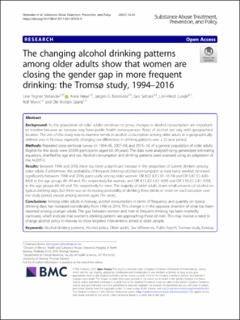| dc.contributor.author | Stelander, Line Tegner | |
| dc.contributor.author | Høye, Anne | |
| dc.contributor.author | Bramness, Jørgen Gustav | |
| dc.contributor.author | Selbæk, Geir | |
| dc.contributor.author | Lunde, Linn Heidi | |
| dc.contributor.author | Wynn, Rolf | |
| dc.contributor.author | Grønli, Ole Kristian | |
| dc.date.accessioned | 2021-08-13T06:58:35Z | |
| dc.date.available | 2021-08-13T06:58:35Z | |
| dc.date.created | 2021-04-14T13:07:56Z | |
| dc.date.issued | 2021 | |
| dc.identifier.issn | 1747-597X | |
| dc.identifier.uri | https://hdl.handle.net/11250/2767684 | |
| dc.description.abstract | Background
As the population of older adults continues to grow, changes in alcohol consumption are important to monitor because an increase may have public health consequences. Rates of alcohol use vary with geographical location. The aim of this study was to examine trends in alcohol consumption among older adults in a geographically defined area in Norway, especially changing sex differences in drinking patterns over a 22-year period.
Methods
Repeated cross-sectional survey (in 1994–95, 2007–08, and 2015–16) of a general population of older adults. Eligible for this study were 20,939 participants (aged 60–99 years). The data were analysed using generalized estimating equations, stratified by age and sex. Alcohol consumption and drinking patterns were assessed, using an adaptation of the AUDIT-C.
Results
Between 1994 and 2016, there has been a significant increase in the proportion of current drinkers among older adults. Furthermore, the probability of frequent drinking (alcohol consumption at least twice weekly) increased significantly between 1994 and 2016, particularly among older women; OR 8.02 (CI 5.97–10.79) and OR 5.87 (CI 4.00–8.63) in the age groups 60–69 and 70+ respectively for women, and OR 4.13 (CI 3.42–4.99) and OR 3.10 (CI 2.41–3.99), in the age groups 60–69 and 70+ respectively for men. The majority of older adults drank small amounts of alcohol on typical drinking days, but there was an increasing probability of drinking three drinks or more on each occasion over the study period, except among women aged 70+ years.
Conclusions
Among older adults in Norway, alcohol consumption in terms of frequency and quantity on typical drinking days has increased considerably from 1996 to 2016. This change is in the opposite direction of what has been reported among younger adults. The gap between women and men in frequent drinking has been markedly narrowed, which indicate that women’s drinking patterns are approaching those of men. This may involve a need to change alcohol policy in Norway to more targeted interventions aimed at older people. | en_US |
| dc.language.iso | eng | en_US |
| dc.publisher | BMC | en_US |
| dc.rights | Navngivelse 4.0 Internasjonal | * |
| dc.rights.uri | http://creativecommons.org/licenses/by/4.0/deed.no | * |
| dc.title | The changing alcohol drinking patterns among older adults show that women are closing the gender gap in more frequent drinking: the Tromsø study, 1994–2016 | en_US |
| dc.type | Journal article | en_US |
| dc.type | Peer reviewed | en_US |
| dc.description.version | publishedVersion | en_US |
| dc.rights.holder | Copyright The Author(s). 2021 | en_US |
| dc.source.articlenumber | 45 | en_US |
| cristin.ispublished | false | |
| cristin.fulltext | original | |
| cristin.qualitycode | 1 | |
| dc.identifier.doi | 10.1186/s13011-021-00376-9 | |
| dc.identifier.cristin | 1904016 | |
| dc.source.journal | Substance Abuse Treatment, Prevention, and Policy | en_US |
| dc.identifier.citation | Substance Abuse Treatment, Prevention, and Policy. 2021, 16, 45. | en_US |
| dc.source.volume | 16 | en_US |

